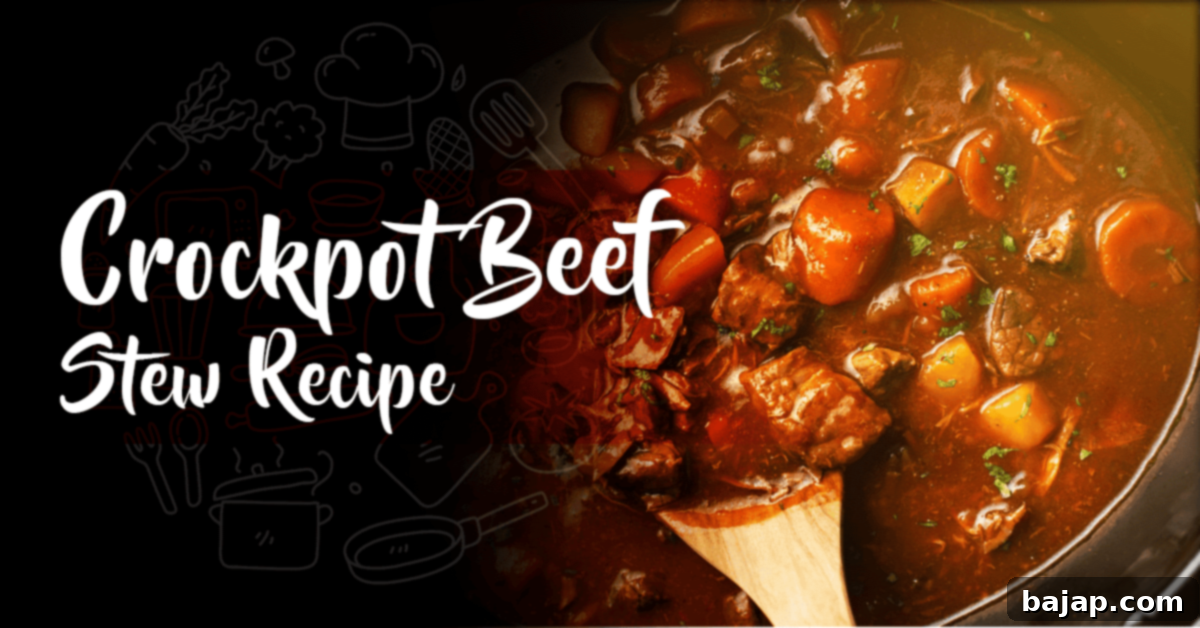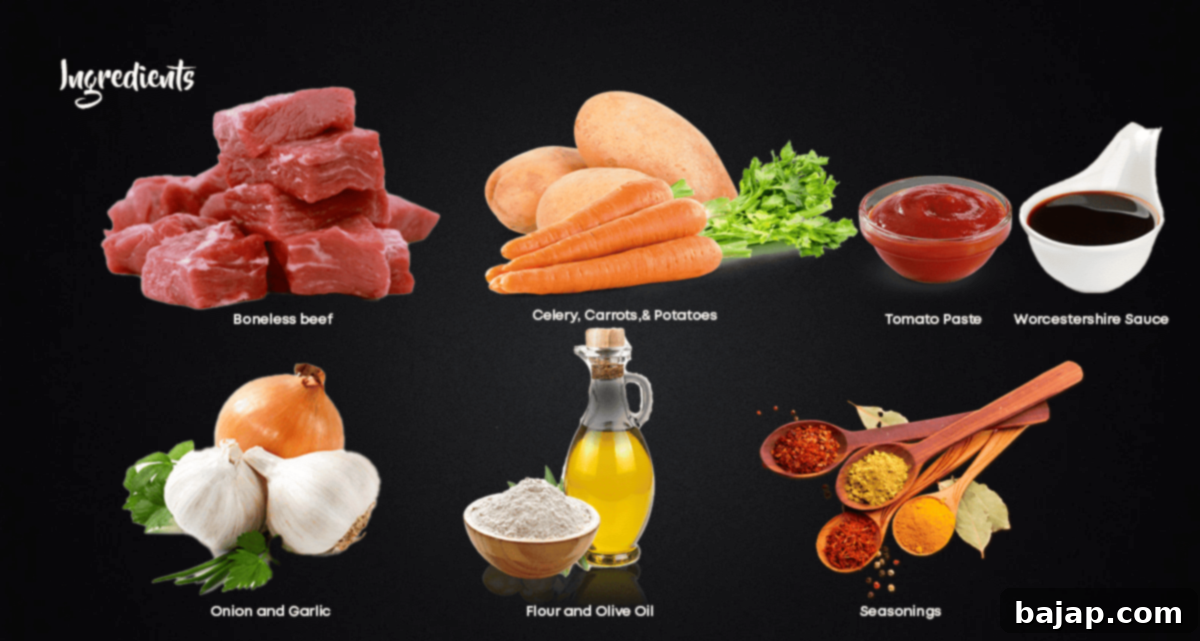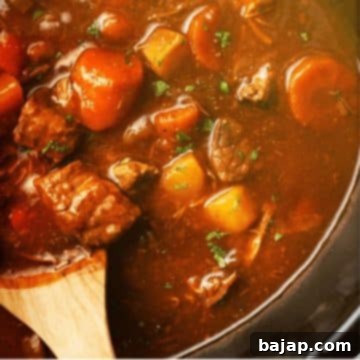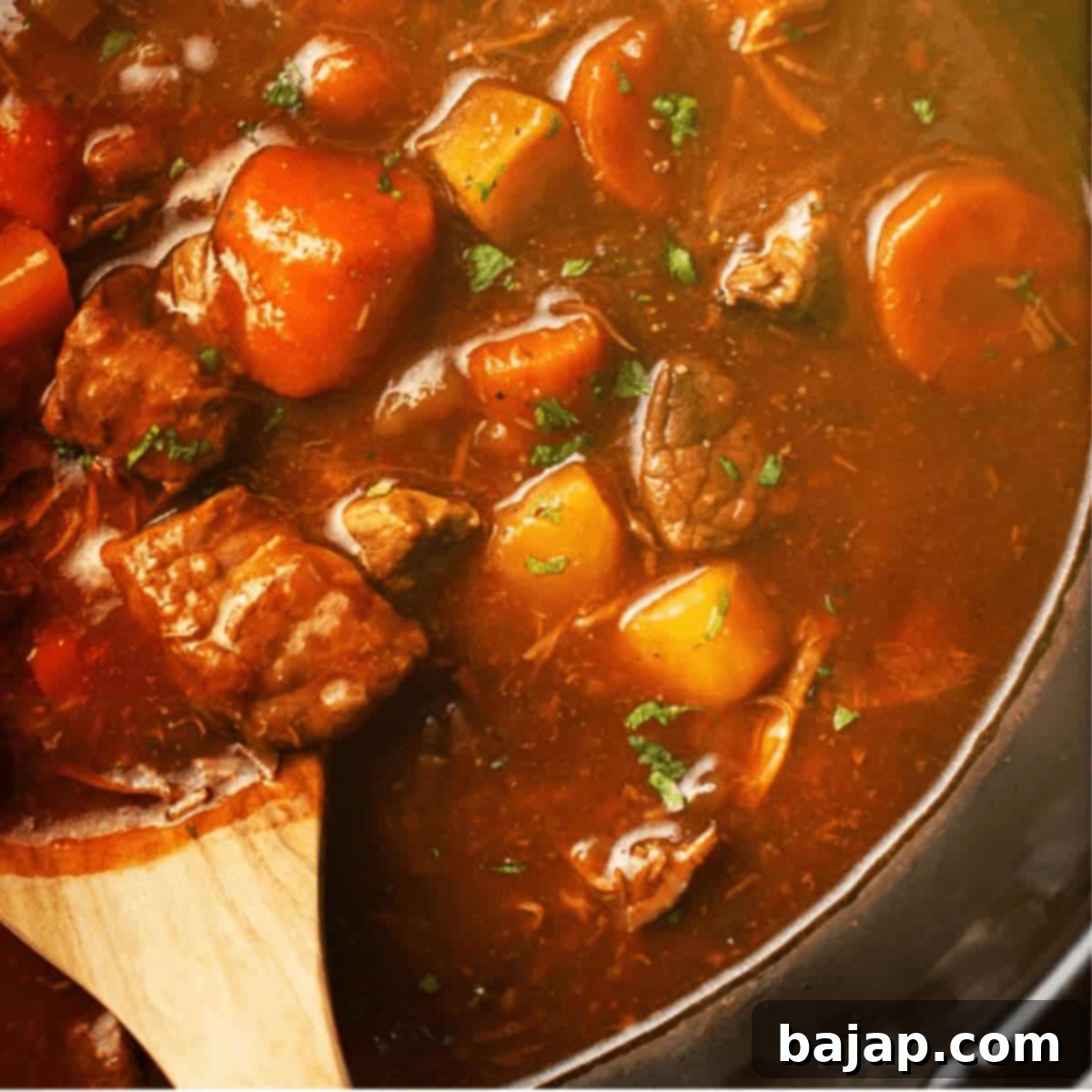Ultimate Comfort: Easy & Hearty Crockpot Beef Stew Recipe for a Flavorful Family Meal
There are few dishes that evoke the same sense of warmth, comfort, and nostalgia as a classic Beef Stew. It’s a truly quintessential meal, perfect for those crisp Sunday evenings when you gather with family or simply desire a deeply satisfying, home-cooked feast after a long day. This Crockpot Beef Stew recipe isn’t just a meal; it’s an experience – a rich, savory, and incredibly tender dish loaded with wholesome vegetables that’s surprisingly light on your tummy. It’s the ultimate antidote to a demanding week, offering both nourishment and soul-soothing flavors.

Thank you, Sophia, for this wonderful guest post! 💚
Why Choose a Slow Cooker for Your Beef Stew?
This particular beef stew recipe harnesses the magic of slow cooking, turning a simple collection of ingredients into a culinary masterpiece with minimal effort. At its heart lies a robust beef chuck roast, paired with an array of garden-fresh vegetables, all gently simmered to perfection in a trusty slow cooker. It’s the quintessential “set it and forget it” meal, allowing you to go about your day while your kitchen fills with the most incredible aromas, promising an exquisite dinner awaiting your return.
The beauty of slow cooking lies in its ability to transform tough cuts of meat into unbelievably tender, fall-apart morsels. As the beef chuck roast cooks for hours on a low, steady heat, its connective tissues slowly break down, rendering each piece succulent and juicy. This extended cooking time also allows the flavors from every ingredient – the rich beef broth, the aromatic vegetables, and the savory seasonings – to meld and deepen. The result is a vibrant, extraordinarily flavorful broth and vegetables that are not just tender, but utterly delectable, each bite bursting with harmonized taste.
Beyond the undeniable deliciousness, Slow Cooker Beef Stew is a truly satiating meal that appeals to everyone who appreciates wholesome, homemade food. Its warmth and inviting aroma make it an ideal choice for the chilly winter months, offering a comforting embrace that can soothe the coldest of days. It’s also incredibly versatile and forgiving, perfect for both novice cooks and seasoned chefs alike, ensuring a delightful outcome every time.
The Benefits of Slow Cooking:
- Unmatched Tenderness: Low and slow heat breaks down tough muscle fibers and collagen in beef, resulting in incredibly tender, melt-in-your-mouth meat.
- Deep Flavor Development: Extended simmering allows ingredients to fully infuse the broth, creating a complex, rich, and well-rounded flavor profile that simply can’t be rushed.
- Convenience: The “set it and forget it” nature of a slow cooker means minimal hands-on time. Prep in the morning, and dinner is ready by evening.
- Cost-Effective: Slow cooking is ideal for less expensive cuts of meat, like chuck roast, making it a budget-friendly option for hearty family meals.
- Healthier Cooking: Slow cooking often requires less fat and helps retain nutrients in vegetables due to gentle cooking.
- Perfect for Meal Prep: Beef stew reheats beautifully and often tastes even better the next day, making it excellent for leftovers or weekly meal planning.
[feast_advanced_jump_to]
The Ultimate Crockpot Beef Stew Recipe Guide
🥘 Slow Cooker Beef Stew Ingredients: The Building Blocks of Flavor
Every great stew starts with a carefully selected array of ingredients that contribute to its overall depth and character. Here’s a detailed look at what makes this crockpot beef stew truly exceptional:

- Onion and Garlic: These are the foundational aromatics of almost any savory dish, and beef stew is no exception. They contribute a deeply savory and fragrant base layer of flavor that permeates the entire stew. Feel free to choose your preferred cut for the onions – smaller dice for a more integrated flavor or larger slices if you like distinct onion pieces.
- Celery, Carrots, and Potatoes: This trio forms the traditional vegetable core of classic beef stew, often referred to as a “mirepoix” when diced fine, though here they’re chunkier for a heartier texture. We specifically recommend Yukon Gold potatoes for their rich, buttery flavor and creamy texture that holds up well during slow cooking without becoming mushy. However, baby potatoes or red potatoes are also excellent choices, offering a slightly different firmness.
- Tomato Paste: Don’t let the name fool you – tomato paste is not here to turn your beef stew into pasta sauce! Its primary role is twofold: it adds a crucial layer of umami depth, enriching the overall flavor, and it acts as a subtle thickening agent for the beef broth, contributing to a luxuriously rich gravy.
- Worcestershire Sauce: This fermented condiment is a secret weapon for adding an incredible depth of savory, tangy, and slightly sweet flavor to the stew. It brings a complexity that is hard to replicate. If you’re not a fan or don’t have it, a dash of soy sauce or balsamic vinegar can offer a similar umami boost, though with a different flavor profile. You can often find specialty sauces like this at a local oil and vinegar store or most major supermarkets.
- All-Purpose Flour and Olive Oil: These ingredients are vital for creating a flavorful crust on your beef and thickening your stew. Browning the beef, followed by sautéing the onion and garlic in olive oil, is a crucial step. The flour coating on the beef helps create a beautiful, caramelized crust through the Maillard reaction, which locks in juices and builds incredible flavor. As the stew cooks, this flour also gently thickens the broth, creating that desirable rich, spoon-coating consistency.
- Seasonings: A harmonious blend of seasonings elevates this stew from good to extraordinary. Italian seasoning (a mix of oregano, basil, thyme, rosemary, and marjoram), dried thyme, and bay leaf provide a warm, herbaceous aroma and taste. Salt and freshly ground black pepper are essential for enhancing all the other flavors. Remember to always season to taste, especially with salt, as broth can vary in sodium content.
- Beef Broth: The liquid base of your stew. Using a low-sodium beef broth is highly recommended. This allows you complete control over the final salt content of your dish, letting you adjust it perfectly to your preference after the long cooking process. Homemade beef broth will, of course, provide the richest flavor.
- Boneless Chuck Roast: This is arguably the best cut of beef for stew, especially for slow cooking. Chuck roast is known for its excellent marbling, which contributes to incredible flavor and tenderness once the connective tissues have broken down over hours of slow simmering. Cut into 1-inch pieces, it becomes fall-apart tender without drying out. Other suitable cuts include beef round or beef short ribs, though chuck roast offers the most consistent results for this type of stew.
See the recipe card below for exact quantities.
🔪 Instructions: Crafting Your Perfect Slow Cooker Beef Stew
Making this hearty beef stew in your slow cooker is straightforward, but a few key steps ensure maximum flavor and perfect texture. Follow these instructions for a truly exceptional meal:
How to Make Slow-Cooker Beef Stew Recipe Step-by-Step
- Prepare the Beef: Begin by coating your beef chuck chunks. In a large zip-top bag or a spacious mixing bowl, combine the beef pieces with the all-purpose flour, salt, and pepper. Shake or stir well to ensure each piece of beef is evenly coated. This flour coating is crucial for browning and thickening.
- Sear the Beef for Flavor: This is arguably the most critical step for developing deep flavor in your stew. Heat a tablespoon of olive oil in a large frying pan or Dutch oven over medium-high heat until shimmering. Brown the floured beef in batches, if necessary, to avoid overcrowding the pan. You want a deep, golden-brown crust on all sides of the beef. This caramelization (the Maillard reaction) creates an incredible depth of flavor that a slow cooker alone cannot achieve. Once seared, transfer the beef cubes to the bottom of your slow cooker.
- Sauté Aromatics: With your skillet still hot and retaining those delicious beef drippings, add a little more olive oil if needed. Sauté the chopped onion and minced garlic for a few minutes until softened and fragrant. This step extracts their sweet and savory notes, building another layer of flavor for your stew. You can deglaze the pan with a splash of beef broth, scraping up any browned bits, and add this flavorful liquid to the slow cooker as well.
- Layer the Ingredients: Now, add all the remaining ingredients – the carrots, potatoes, celery, tomato paste, Worcestershire sauce, beef broth, and all seasonings (Italian seasoning, dried thyme, bay leaf, ground paprika). Arrange the vegetables on top of the seared beef in the slow cooker, then pour in the liquid. Ensure the liquid just barely covers the ingredients; you don’t want to drown them.
- Adjust Seasonings & Cook: Before starting the cooking process, give the mixture a good stir and taste the broth. Remember to always start with less salt, as flavors will concentrate during cooking. You can always add more salt to taste once the beef stew is fully cooked and the flavors have melded. Cover the slow cooker.
- Slow Cook to Perfection: Cook the beef stew on a low heat setting for 7-8 hours, or on a high heat setting for 3-4 hours. Cooking on low for a longer duration typically yields the most tender beef and deeply developed flavors. The stew is ready when the beef is fork-tender and the vegetables are soft.
- Serve and Enjoy: Once cooked, remove the bay leaf. Ladle the hot, fragrant stew into bowls. Relish the rich taste and comforting warmth! This stew pairs wonderfully with crusty bread, mashed potatoes, or a side of rice.

How to Thicken the Beef Stew for Perfect Gravy
This recipe is designed to produce a thick and hearty stew using the flour coated on the beef and the tomato paste. As the stew cooks slowly, the broth naturally thickens, and will continue to thicken slightly as it cools. If you prefer an even richer, thicker gravy-like consistency, you can easily adjust it towards the end of the cooking process:
- Cornstarch Slurry Method: In a small bowl, stir together 2 tablespoons of cornstarch with 2 tablespoons of cold water until a smooth slurry forms.
- Add to Stew: Stir this cornstarch slurry into the hot stew in the slow cooker.
- Continue Cooking: Cover the slow cooker and cook on high heat for another 20-30 minutes, or until the stew has reached your desired thickness, stirring occasionally to prevent sticking and ensure even thickening. The cornstarch will create a glossy, thick gravy.
🌡 Storage and Reheating Tips for Leftovers
One of the many joys of beef stew is how wonderfully it keeps, often tasting even better the next day as the flavors continue to meld. Proper storage and reheating ensure you can enjoy this delicious meal for days to come:
- Refrigeration: Allow the beef stew to cool completely before transferring it to an airtight container. It can be safely refrigerated for up to 3 days.
- Freezing: For longer storage, beef stew freezes beautifully. Once cooled, transfer the stew to freezer-safe containers or heavy-duty freezer bags. You can store it in the deep freezer for approximately three months. Be aware that potatoes may alter their texture slightly, becoming a bit softer or mealier upon thawing and reheating.
- Thawing Frozen Stew: To thaw, simply transfer the frozen stew from the freezer to the refrigerator overnight. For a quicker thaw, you can also use the defrost setting on your microwave.
- Reheating on the Stovetop: For best results, place the thawed stew in a pot or Dutch oven. Cover it and warm it over medium heat, stirring occasionally, until it is heated through. If the stew seems too thick, you can add a splash of beef broth or water to reach your desired consistency.
- Reheating in the Microwave: Beef stew can also be reheated in the microwave. Place a single serving in a microwave-safe bowl, cover, and heat on high power, stirring every minute or so, until thoroughly warmed. Be careful not to overheat, which can make the beef tough.
💭 Expert Tips & Recipe Notes for the Best Crockpot Beef Stew
- Mind Your Beef Cube Size: Aim for beef chunks roughly 1 to 1.5 inches. If you cut the beef cubes too small, they risk falling apart and losing their texture before they can fully absorb all the incredible flavors developed during the slow cooking process. Too large, and they might take longer to become tender.
- Don’t Skip the Browning! This step cannot be stressed enough. Browning the beef before adding it to the slow cooker is the “secret ingredient” to a truly flavorful stew. The Maillard reaction, which occurs during searing, creates hundreds of new flavor compounds and a beautiful crust on all beef pieces. This extra measure is absolutely necessary to build deep, rich taste that forms the foundation of your stew. Do it in batches if needed to ensure proper searing, rather than steaming.
- Potato Choices and Preparation: While Yukon Gold potatoes are recommended for their creamy texture, feel free to use baby potatoes or even red potatoes. If using baby potatoes, peeling is optional as their skins are thin. For larger potatoes, quartering them will ensure they cook evenly and are a manageable size in the stew.
- Broth Substitution: Beef broth provides the most authentic and rich flavor. However, if you find yourself without it, chicken broth can be used as a substitute. Just be aware that the overall flavor of the stew will be less robust and might require additional seasoning, perhaps a touch more Worcestershire or even a splash of red wine, to compensate for the difference.
- Don’t Overcrowd the Slow Cooker: Fill your slow cooker to about two-thirds capacity to ensure even cooking and proper heat distribution. Overfilling can extend cooking times and lead to unevenly cooked ingredients.
- Resist the Urge to Peek: Opening the slow cooker lid frequently releases heat and prolongs the cooking time. Try to keep the lid on as much as possible to maintain a consistent cooking temperature.
Variations & Customizations to Make It Your Own
While this recipe is a classic for a reason, don’t hesitate to experiment and tailor it to your personal preferences or what you have on hand:
- Add More Vegetables: Feel free to toss in other hearty vegetables like parsnips, turnips, green beans, or even mushrooms during the last hour of cooking.
- Spice It Up: For a touch of heat, add a pinch of red pepper flakes with the other seasonings.
- Herbs & Spices: Fresh rosemary or a sprig of fresh thyme added during the last hour of cooking can impart a more vibrant herbal note. A bay leaf is included, but feel free to add another!
- Different Liquids: A splash of red wine (about ½ cup) added during the sautéing of the onions can deglaze the pan and add incredible depth to the broth. Reduce the beef broth slightly if adding wine.
- Gluten-Free Option: To make this stew gluten-free, substitute the all-purpose flour with a gluten-free flour blend (like rice flour or cornstarch for coating) or simply skip the flour coating and thicken the stew with a cornstarch slurry at the end.
Perfect Serving Suggestions
A well-made beef stew is a meal in itself, but it truly shines when served with the right accompaniments:
- Crusty Bread: Essential for soaking up every last drop of that glorious gravy.
- Mashed Potatoes: A creamy bed of mashed potatoes is a classic pairing, offering a delightful texture contrast.
- Rice or Noodles: White rice, brown rice, or wide egg noodles can also serve as a great base for the stew.
- Polenta: Creamy polenta provides a comforting and absorbent accompaniment.
- Side Salad: A fresh, crisp green salad with a light vinaigrette can cut through the richness of the stew, offering a refreshing contrast.
📖 Recipe

How to Make Slow-Cooker Beef Stew
Sophia
Save RecipeSaved!
Pin Recipe
Equipment
-
4- to 6-quart Crockpot
-
Measuring cups and spoons
-
Chef’s knife and cutting board
-
Mixing bowls
-
Large skillet
-
Tongs
Equipment
-
4- to 6-quart Crockpot
-
Measuring cups and spoons
-
Chef’s knife and cutting board
-
Mixing bowls
-
Large skillet
-
Tongs
Ingredients
- 2 pounds beef stew meat cut into 1-inch pieces
- ¼ cup all-purpose flour
- ½ teaspoon salt
- ½ teaspoon ground black pepper
- 1 ½ cups beef broth
- 4 medium carrots sliced
- 3 medium potatoes diced
- 1 medium onion chopped
- 1 stalk celery chopped
- 1 teaspoon Worcestershire sauce and Tomato Paste
- 1 teaspoon ground paprika
- 1 clove garlic minced
- 1 large bay leaf and dried thyme
- 1 teaspoon olive oil
Instructions
-
Mix the beef chunks in flour, salt, and pepper. Shake the beef, flour, salt, and pepper in a large zip-top bag, or stir them in a large mixing bowl.
-
Sauté the ground beef. It is essential to brown the meat in a frying pan before adding it to the slow cooker. This step creates a mouthwatering thick layer on the beef pieces and sears in the meat juices. Place the beef cubes at the bottom of your slow cooker after searing them.
-
Sauté the onion and garlic. Because you have a hot skillet, searing the onion and garlic in the beef drippings for a few minutes is easy. You’re adding delicious flavor layers to your stew.
-
Now add all the other contents, like vegetables, into the pot.
-
Seasonings should be tasted and adjusted. Always start with less salt. If required, add the salt once the beef stew is fully cooked.
-
Serve hot, and relish the taste in your mouth!
Notes
How to Thicken the Beef Stew
This recipe uses flour and tomato paste to naturally thicken the beef stew. As the stew cooks slowly, the broth will gradually thicken and continue to achieve a richer consistency as it cools. This stew is inherently thick and hearty, but if you desire an even more substantial, gravy-like texture, you can easily achieve this by stirring in 2 tablespoons of cornstarch mixed with two tablespoons of cold water to form a smooth slurry. Add this slurry to the stew during the final 20-30 minutes of cooking, and continue on high heat until your preferred thickness is reached.
Nutrition values are estimates only, using online calculators. Please verify using your own data.

❤️ You might also like
- Dutch Oven Mac and Cheese – the absolute comfort food
- Bacon Wrapped Venison Tenderloin
- How to cook Tafelspitz (Austrian Prime Boiled Beef)
- How to make Apfelkren – Austrian Horseradish Sauce
⛑️ Essential Food Safety Guidelines
Ensuring the safety of your food is paramount when cooking, especially with meat-based dishes. Please keep these important food safety practices in mind:
- Cook to Minimum Temperature: Always ensure beef reaches an internal temperature of at least 160 °F (71 °C) for ground beef, and whole cuts like roasts to 145 °F (63 °C) with a 3-minute rest, or 165 °F (74 °C) for stew. Use a reliable meat thermometer.
- Prevent Cross-Contamination: Never use the same utensils, cutting boards, or plates on cooked food that have previously touched raw meat without thorough washing and sanitization.
- Handwashing: Always wash your hands thoroughly with soap and warm water for at least 20 seconds after handling raw meat.
- Temperature Danger Zone: Do not leave cooked food sitting out at room temperature for extended periods (more than two hours). Bacteria multiply rapidly between 40 °F (4 °C) and 140 °F (60 °C).
- Never Leave Cooking Food Unattended: Especially when searing meat or sautéing on the stovetop, always keep an eye on your food to prevent burning or other hazards.
- High Smoking Point Oils: When searing or frying, use oils with a high smoke point (like olive oil, canola oil, or avocado oil) to avoid burning the oil and creating harmful compounds.
- Adequate Ventilation: Ensure good ventilation in your kitchen, particularly when using a gas stove, to prevent the buildup of fumes and improve air quality.
- Rapid Cooling: To quickly cool down large quantities of stew for storage, divide it into smaller, shallow containers to help it reach refrigeration temperature faster.
For further comprehensive information on safe food handling practices, please consult the Safe Food Handling guide from the FDA.
